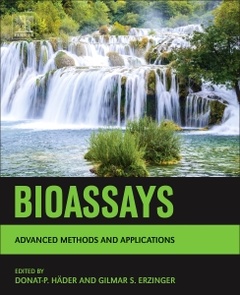Bioassays Advanced Methods and Applications
Coordonnateurs : Hader Donat, Erzinger Gilmar

Bioassays: Advanced Methods and Applications provides a thorough understanding of the applications of bioassays in monitoring toxicity in aquatic ecosystems. It reviews the newest tests and applications in discovering compounds and toxins in the environment, covering all suitable organisms, from bacteria, to microorganisms, to higher plants, including invertebrates and vertebrates. By learning about newer tests, water pollution control testing can be less time and labor consuming, and less expensive. This book will be helpful for anyone working in aquatic environments or those who need an introduction to ecotoxicology or bioassays, from investigators, to technicians and students.
1. Introduction 2. Chemical analysis 3. Short view on the historical development 4. Regulations, political and societal aspects, toxicity limits 5. Technology of image analysis for bioassays 6. Algae 7. Other commercially available bioassays 8. Plant Pigments 9. PAM fluorescence 10. Ecotox 11. Daphniatox 12. Imaging based bioassays (Lemnatox) 13. Fish 14. Mammals 15. Insects worms etc. 16. Plant and animal cells 17. Environmental Monitoring 18. Use of bioassays to monitor toxicity and pollution in drinking water 19. Application of bioassays for polluted freshwater ecosystems 20. Bioassays to determine solar UV radiation 21. Terrestrial 22. Marine toxicology: assays and perspectives for developing countries 23. Conclusion
Advanced students and researchers in ecology, aquatic sciences, environmental technology and water management as well as workers and administrators in the field of waste water treatment, environmental health, drinking water supply and natural ecosystems
Prof. Gilmar S. Erzinger has a Ph.D. in Biochemical Pharmaceutical Technology (2000) from the University of Sao Paulo and made a Post Doctorate in Photobiology at Friedrich Alexander Univesitat Erlangen-Nuremberg, Germany (2009). He gives courses in Medicine and Pharmacy, on the Health and Environment Programme at the University of Joinville Region and Program in Biotechnology and Biosciences, UFSC, Brazil. He is working on productivity in Technological Development and Innovative Extension by CNPq, Brazil. He is author of over 35 scientific publications, produced two books and holds seven national and international patents. His research interests are ecotoxicology of aquatic ecosystems and biotechnology processes and is a researcher at the Foundation for Research and Innovation of the State of Santa Catarina, Brasil.
- Features chapters written by internationally renowned researchers in the field, all actively involved in the development and application of bioassays
- Gives the reader an understanding of the advantages and deficiencies of available tests
- Addresses the problem of understanding the impact of toxins in an aquatic environment and how to assess them
Date de parution : 10-2017
Ouvrage de 464 p.
15x22.8 cm
Thèmes de Bioassays :
Mots-clés :
Acute fish test; Air; Algae; Analytical measurements; Anions; Antibiotics; Antioxidant activity; Aquatic ecosystems; Artemia Mysidopsis juniae; Artificial streams and ponds; Bacillus subtilis; Bioassay; Bioassays; Biofilm; Biofiltration; Bioluminescence; Bioluminescent organisms; Biomass productivity; Biomonitoring; Biorefinery; Breeding; Cell tracking; Channelrhodopsins; Chemical analysis of toxicity; Chlorophyll; Chlorophyll fluorescence; Contamination; Crop research; Cyanotoxins; DNA; Daphnia; Daphniatox; Delayed fluorescence; Dinoflagellates; Drinking water; ECOTOX; Early Life Stage Test (ELST); Ecophysiology; Ecotox; Ecotoxicology; Effective concentrations; Effects monitoring; Embryonic development and UV-B; Enclosures; Environmental stress; Euglena; Euglena gracilis; Field studies; Fish; Fish cell line test; Fish-biomarker; Flagellates; Fluorescence parameters; Fluorescence quenching; Fluorimeters; Gravitactic orientation; Gravitaxis; HPLC; Hazardous red tides; Heavy metals; Human health hazards; Image analysis; Image enhancement; Image processing; Immunostimulants; In-situ exposure; Industrial wastewater; LUMIStox; Lemna; Marine pollution; Marine toxicology; Mechanical stress; Metals; Microalgae; Microbiotests; Microtox; Motility; Movement analysis; Noninvasive sensors; Object identification; Organismic-sensor; Orientation; Oxygen production; PAM; PI-curves; Perna perna; Pesticides; Phagocytosis and microgravity; Phenotyping; Photoinhibition; Photosynthesis; Photosynthetic pigments; Phototaxis; Pigments; Plant science; Political; Pollutants; Pollution; Precision agriculture; Primary production



